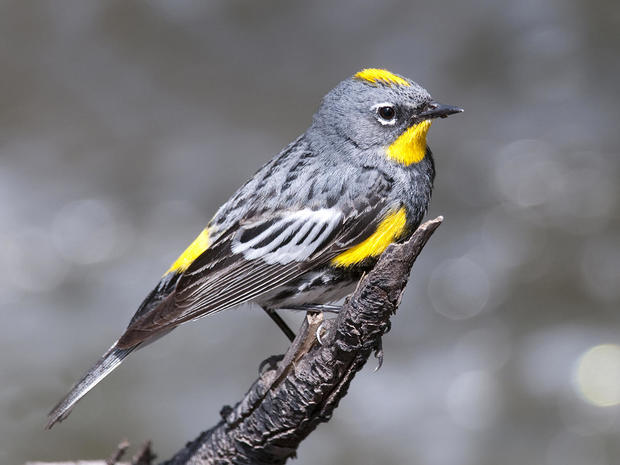Nature up close: Bird migration
By "Sunday Morning" contributing videographer Judy Lehmberg.
I recently read there were probably no seasons -- winter, spring, summer, fall -- when the Earth first formed. Then I started thinking about the birds we've been filming for the last few weeks at Bosque del Apache National Wildlife Refuge in New Mexico. Most of the birds in the refuge (such as ducks, geese, sandhill cranes, and even some of the smaller birds, like warblers) migrate. Why do we have seasons, and what does that have to do with bird migration?
The Earth has undergone many dramatic changes since the solar system formed around 4.6 billion years ago, when a star exploded, creating a supernova and a resulting pressure wave which squeezed a cloud of stellar gas, dust and larger particles to compress and coalesce into planets, with a superhot sun in the center.
When the Earth was still quite young, a large object about the size of Mars struck it. Some of the ejected material coalesced into our Moon. For hundreds of millions of years after the Moon formed, other large objects have hit the Earth and were incorporated into it. All of these collisions brought about a shift in Earth's rotational axis. The very early rotational axis, before the collision that formed the Moon, was probably perpendicular to the plane of the solar system, with the equator constantly receiving the sun's rays at 90 degrees. This early world had no seasons, with all parts of the Earth receiving the same amount of daylight and nighttime all year long. The shift to the present axis of rotation, 23.5 degrees, is the reason we have seasons.
It is hard to think of the Earth without seasons … no winter, no summer, no differences from one time of year to the next. However, our planet has had seasons for a long, long time. All of Earth's organisms have had to adapt to changing conditions -- dry seasons vs. rainy seasons in the tropics, and major temperature differences between winter and summer in the temperate regions.
What does the Earth's axis have to do with bird migration? Everything. Because the tilt of the Earth results in seasonal variations, birds had to adapt to be able to find enough food at any time of year. Although not all birds migrate, many do, and they do so because they would run out of food if they didn't. Migratory birds in the Northern Hemisphere spend their winter in the southern U.S., Mexico, Central America and South America, and move to the northern U.S. and Canada in the summer to nest. As their northern breeding areas begin to cool in the fall, there is less food available, so they go south to find new food supplies.
While watching a huge flock of snow geese in Bosque del Apache a few day ago, I realized how far they had to travel to get here. They nest in the tundra of northern Canada, so they migrate about 3,000 miles to their wintering grounds. Even driving 3,000 miles is tiring; can you imagine having to flap your wings the whole way?
Many small North American birds, such as warblers and hummingbirds, migrate from Canada and the U.S. across the Gulf of Mexico to winter in South America. In the spring they leave the coast of South America in the evening and arrive on the northern coast of the Gulf of Mexico the next day around 2:00 p.m., if the winds are in their favor.
Arctic terns are the champion migrators. They travel from the Arctic to Antarctica and back each year, covering 44,000 miles annually. Because they can live 30 years, that can add up to 1.5 million miles in a lifetime.
In North America the four principal migration routes are the Pacific, Central, Mississippi and Atlantic flyways. Birds at Bosque del Apache travel the Central flyway, and in New Mexico follow the Rio Grande to the refuge. As winter progresses, many species of birds proceed further south, where the flyways constrict in Panama and then diverge into South America.
Pintail ducks are usually the first ducks to migrate towards warmer temperatures in the fall, arriving in Bosque del Apache in November. They feed in shallow ponds by turning their sharp tail towards the sky and "dabble" with their feet, treading water and eating vegetation on the bottom. Many continue on south as colder weather settles in New Mexico, finishing the winter in Mexico and Central America. Northern mallards are another dabbling duck commonly seen on the refuge.
Mallards are at the other end of the migration spectrum, often the last ducks to head south, and usually don't go further than the southern states of New Mexico and Arizona (as well as Baja California). The distinctive green head of the mallard drake stands out from all of the other ducks in Bosque.
Fall and spring migrations are favorite times for birdwatchers and photographers, with large numbers of people flocking, along with the birds, to places such as Bosque del Apache; Hawk Ridge in Minnesota; Utah's Great Salt Lake; Monterey Bay, California; High Island, Texas; Magee Marsh Wildlife Area in Ohio; Cape May, New Jersey; California's Point Reyes; and even New York's Central Park.
Cornell Lab of Ornithology has produced a great graphic of bird migration. It will make you tired to watch, but look for 106, the white-rumped sandpiper at allaboutbirds.org. The research compiled there came from the eBird database, a citizen science initiative where anyone can contribute information.
Judy Lehmberg is a former college biology teacher who now shoots nature videos.
For more info:
- Judy Lehmberg (Official site)
- Judy Lehmberg's YouTube Channel
To watch extended "Sunday Morning" Nature videos click here!





